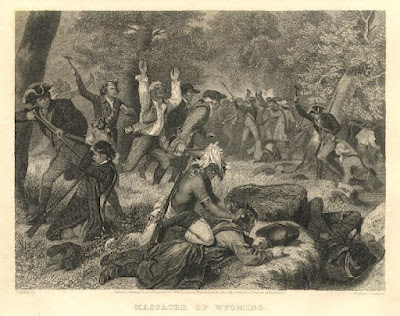© 2022 Christy K Robinson
We are taught stories about heroic men who gave their lives to bring independence and liberty to their families, friends--and of course, to the people who would come long after they passed, whether in war or in their beds of old age. But we rarely learn of what women endured during wartime. There's no detailed history of Sarah Adams Stevens, only what can be learned by association with men of the time.
Some of my US patriot ancestors were massacred on 3 July 1778 by Mohawks who were paid bounties for scalps, by the British, or the American Tories loyal to the British. Scalping was a particularly gruesome and painful way to die, since the scalps were stripped from the skulls while the victim may still have been wounded but alive. Stories I read about the Massacre of Wyoming cited British loyalist officers from Connecticut as commanders of the battle. My patriot ancestors were from Fairfield, Connecticut. They may have known the men behind their deaths.
Among the fallen in the Massacre of Wyoming (Wyoming, Pennsylvania) was Lt Asa Stevens, my 5x great-grandfather on my Robinson side.
Asa's and 300 other men's remains were later interred in a cemetery where a 60-foot cenotaph was erected.
Asa's 245th birthday was 2 days ago, May 27. He was only 44 when he was hacked to death. His 15-year-old son Roger died a week later while the family was fleeing the Wyoming Valley in the wake of the massacre. Roger was buried in the wilderness and the family had to move on through forests and mountains, during a war in which Indians killed women and children or took them captive as slaves. (This happened to other ancestors.) The journey to Connecticut must have been terrifying, even as they were suffering grief over Sarah's dead husband and son.
Sarah's son Jonathan wrote later that the family returned on foot to Canterbury, Connecticut, where Sarah had been born, and stayed until the end of the Revolution, when they moved back to Wilkes-Barre, Pennsylvania.
The only relative I find for Sarah in Canterbury was her brother Timothy Adams, married to their cousin Susanna Adams. Timothy was also serving in the Revolutionary War. Timothy and Susanna had seven young children, and Sarah had nine children remaining after Roger died, so that's a household of 16 children and two women, if that's where Sarah landed in 1778. We can imagine that there were other families like theirs, in colonial America.
Four years after her husband's death in 1778, Sarah appeared in Forkston Township, back in the Wyoming, Pennsylvania area, about 30 miles from Wilkes-Barre. Forkston is where her 10-year-old son Phineas died.
I don't know if she was farming by herself, or with friends or relatives from her hometown. She didn't remarry. Her father was long dead; so was her father-in-law. Her children were young, and don't appear to have been raised by relatives. Sarah Adams Stevens must have developed a support system of neighbors, and possibly a cottage industry along with farm income.
Sarah lived only to age 55, a few years after the Revolutionary War came to an end. Her world had been at war for 40 of her 55 years. She had trekked between Connecticut and Pennsylvania three times, with babies or young children in tow, in danger every step of the way.
How are we connected?
Lt Asa Stevens and Sarah Adams, mid-1700s.
Asa Stevens Jr and Esther Downing (as in Downing Street, London).
Cynthia Stevens and William Riley Robinson.
Stevens Allison Robinson and Harriet Grist.
Wesley L Robinson and Isabella Hamner.
(For many of us, Wesley's and Isabella's children are our grandparents or great-grands.)
***********
Christy K Robinson is author of these books (click the colored title):
We Shall Be Changed (2010)
Mary Dyer Illuminated Vol. 1 (2013)
Mary Dyer: For Such a Time as This Vol. 2 (2014)
The Dyers of London, Boston, & Newport Vol. 3 (2014)
Effigy Hunter (2015)
And of these sites:
Discovering Love (inspiration and service)
Rooting for Ancestors (history and genealogy)
William and Mary Barrett Dyer (17th century culture and history of England and New England)
Editornado [ed•i•tohr•NAY•doh] (Words. Communications. Book reviews. Cartoons.)





